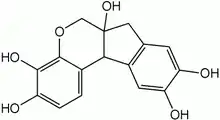hematoxylin
English

Molecular structure of hematoxylin
Alternative forms
Etymology
From Haematoxylum (“genus of the logwood tree”) + -in.
Pronunciation
- (Received Pronunciation) IPA(key): /ˌhiːməˈtɒksɪlɪn/
- (General American) IPA(key): /ˌhiməˈtɑksɪlɪn/
Noun
hematoxylin (plural hematoxylins)
- (medicine, organic chemistry) A phenolic compound having the chemical formula C16H14O6, used (most often in conjunction with eosin) to make dye for staining tissue samples; extracted from the heart of the bloodwood tree, Haematoxylum campechianum.
- 1995 December 23, N. Jaax et al., “Transmission of Ebola virus (Zaire strain) to uninfected control monkeys in a biocontainment laboratory”, in The Lancet, volume 346, number 8991, PMID 8551825, page 1669:
- Histology sections were cut at 5–6 µm on a rotary microtome, mounted on glass slides, and stained with Harris’s haematoxylin and eosin in a Stainomatic specimen stainer.
- 2001, Laura E. Edsberg; Joseph R. Natiella; JoAnn Earle, “Microstructural characteristics of human skin subjected to static versus cyclic pressures”, in Journal of Rehabilitation Research and Development, volume 38, number 5:
- The stains used were hematoxylin and eosin (H&E), Masson's trichrome, and Verhoeff's stain. Sections stained with hematoxylin and eosin have nuclei that were stained blue, cartilage and calcium deposits stained dark blue, cytoplasm and other constituents stained shades of red, and blood stained bright red.
-
Further reading
- hematoxylin at OneLook Dictionary Search
- hematoxylin, haematoxylin, hemotoxylin at Google Ngram Viewer
This article is issued from Wiktionary. The text is licensed under Creative Commons - Attribution - Sharealike. Additional terms may apply for the media files.